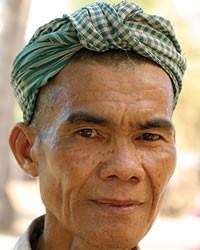Cham, Western in Vietnam

Photo Source:
Copyrighted © 2026
Cambodia Research Network All rights reserved. Used with permission |
Send Joshua Project a map of this people group.
|
| People Name: | Cham, Western |
| Country: | Vietnam |
| 10/40 Window: | Yes |
| Population: | 49,000 |
| World Population: | 342,300 |
| Primary Language: | Cham, Western |
| Primary Religion: | Islam |
| Christian Adherents: | 0.02 % |
| Evangelicals: | 0.00 % |
| Scripture: | New Testament |
| Ministry Resources: | Yes |
| Jesus Film: | Yes |
| Audio Recordings: | Yes |
| People Cluster: | Cham |
| Affinity Bloc: | Southeast Asian Peoples |
| Progress Level: |
|
Introduction / History
The Cham Western can be found near the delta provinces of Chau Doc and Tay Ninh in southwestern Vietnam near the Cambodian border. Surrounded by the Malay and Khmer ethnic groups, they live near the provincial capitals.
The precise origin of the Cham Western is unknown, but they are the survivors of the Champa kingdom, which flourished from A. D. 2 until A.D. 1471. When the Vietnamese invaded their kingdom, most aristocrats fled to Cambodia, whereas the poor peasants remained in Vietnam. Evidence remains of this once flourishing civilization: grandiose temples and sanctuaries, irrigation systems, woven cloth, sculpture, and jewelry.
The Cham Western are a mixture of Cham and Malay, with whom they traded during the time of their powerful kingdom. Their language, Cham, belongs to the Malayo-Polynesian branch of the Austronesian linguistic family. Many Cham Western also speak Vietnamese, Khmer and/or Malayan.
What Are Their Lives Like?
Although they are descendants of a warlike people, the Cham Western today are very timid individually, but courageous as a group. They are extremely honest in word and deed, to the extent that stealing and lying are almost unknown among them. Since ancestral practices must sanction every action, progress tends to be slow among the Cham. As a people they are fond of chess, jewelry and music.
Since the downfall of the Champa Kingdom, the Cham Western has changed from a prosperous seafaring power to a small agrarian culture. Several rivers dissect the region inhabited by the Cham Western, and canals provide irrigation and transportation. In the delta area, extensive drainage projects have converted the marshy ground into cultivated land, where they grow several varieties of rice. To supplement their agricultural earnings, the Cham Western engage in small commerce, such as buying rice from neighbors and transporting it to the cities by boat. They sell corn, tobacco and hand-woven cloth. Some are involved in making carts or in beekeeping.
The Cham Western live clustered in groups on the banks of rivers or canals and along the two roads that connect Cambodia with southern Vietnam and lead into the city. Some occasionally build whole villages on huge, anchored rafts. Their villages are adjacent to the Khmer people, though they seldom intermarry; and they live in better harmony with the Malay, often sharing villages.
Houses are constructed with straw-covered mud walls and have three rooms and a common corridor. Clothes belonging to their ancestors are placed in a basket and hung from the ceiling in the center room. No decorations adorn their homes.
Before merging with the national community of Vietnam, Cham Western society had once been a feudal and matrilineal (lineage traced through the female) society. Under the impact of orthodox Islam, the Cham Western have become more patrilineal (lineage traced through the male), but matrilineal traces still exist. Today, the role of women in clans and families is prominent only in the cult of ancestors; yet women still bear the major responsibility for housework, childrearing, and agricultural activities.
What Are Their Beliefs?
Ancestor worship is the primary religion of the Tay Tac people. They keep ancestral altars inside their homes. Guests cannot sit in front of these altars, and women who have recently given birth are not allowed to look at them, because this would disgrace the ancestors.
What Are Their Needs?
Their primary need is to place their faith in Jesus Christ.
The Tay Tac people need to look to Christ for their security.
Prayer Points
Pray that there will be a movement of the Holy Spirit to result in church plants and discipleship.
Ask the Lord of the harvest to send out loving and dedicated laborers to the Cham Western of Vietnam.
Ask the Lord to raise up an army of intercessors who will pray for them.
Ask the Lord to bring forth a strong and growing Western Cham church to the glory of his name.